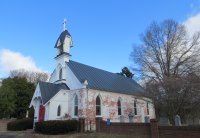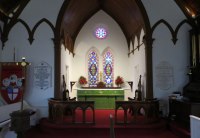St. John’s Episcopal Church
Please join us at St. John’s the first, second and fourth Sundays of the month at 10:00 a.m. for a service of Holy Eucharist.
St. John’s is the mother church of Hanover Parish, which was established in 1776-77. Several earlier churches established in the parish during the colonial period have long since disappeared. St. John’s was built in 1843, following the relocation of the courthouse to a more central location in King George County, the boundaries of which were realigned in 1776 to cover the area between the Rappahannock and Potomac Rivers. At that time, St. John’s was the only church in Hanover Parish. Services were held by priests from adjoining parishes until 1859, when the Rev. Alexander Shiras became rector. Though he was from the North, Mr. Shiras stayed with the church after the Secession. However, when the Protestant Episcopal Church of the Confederate States was organized, he felt he had to resign and did so in 1862. The parish was vacant during the rest of the war years and until 1869; the church has seen continuous service since then.


About Historic Items
Catalog from an exhibition of English, American, and European church silver from Virginia’s colonial past at the Virginia Museum, 1970:
Church Silver of Colonial Virginia
Library of Congress Catalog Card Number: 77-102030
Virginia Museum, Richmond, Virginia 23221
Copyright 1970 by Virginia Museum. All rights reserved
Printed in the United States of America
Chalice, Flagon, Alms Basin or Paten
London 1750-51
William Grundy
St. John’s Church, King George
These simple pieces are each marked with the sacred monogram. William Grundy also made the set in the Eastern Shore Chapel, although the size and date differ. The silver probably has been the Hanover Parish set since its purchase for the second Strother’s Church, built about 1754. The present St. John’s Church was built in 1843 on the site of a previous church.
Chalice: Height 8 ¾ inches
Flagon: Height 10 ¾ inches
Basin: Diameter, 10 inches; height, 1 inch
References: Jones, p. 207; Rawlings, p. 227
Jones, E. Alfred, The Old Silver of American Churches, Letchworth, England, 1913
Rawlings, James Scott, Virginia’s Colonial Churches: An Architectural Guide, Richmond, 1963
A Historical Summary of Hanover Parish
By the time Hanover Parish was formed in 1713, there had been over 100 years of settlement in Virginia with the ensuing forming, combining, and reforming of both county and parish boundaries. Hanover Parish was formed from St. Mary’s Parish, which existed on both sides of the Rappahannock River. The north side became Hanover, at the time in Richmond County. The parish boundaries were Bristol Mines, near the current King George-Westmoreland boundary, to the east, and as far as settlement extended to the west. The two churches in the parish were Strother’s Church, near Port Conway, and Muddy Creek Church in what is now Stafford County just across the King George-Stafford line. Both of these church structures are long gone, now just bare pieces of ground.
In 1732, Hanover’s eastern boundary was extended to the King George County line (King George having been formed in 1720), taking in Brays Church in Leedstown. The western boundary was set at Dogue Run, and Brunswick Parish was formed from the western part of Hanover.
In 1755, Strother’s Church was abandoned and a new church, known as New Strother’s Church, was erected on the “west side of Gingateague Creek” a few miles east of the old church. It’s not clear why the parish church, which was near the original courthouse and therefore in the center of community activity, would have been relocated. It is not known when New Strother’s Church stopped holding services. Two of the many historical mysteries.
In 1778, the parish boundaries were realigned to match the county boundary changes involving King George, Stafford, and Westmoreland, bringing Round Hill Church, near Ninde, into Hanover. The courthouse was moved to its current location on King’s Highway in 1795.
It was decided that a place of worship should be built near the courthouse in King George to replace the old Strother’s Church at Millbank, the earlier courthouse having been moved from Canning in the southwest section of the county. A little more than ½ acre (12 4/5 poles in length with 6 1/3 in width) northeast of the courthouse was donated by Younger Johnson of Woodlawn [the current Rectory property]. A cornerstone was laid in 1842, and a subscription was circulated to raise money for this purpose. Through donations and a fair held by members (proceeds $98.50), $958 was raised. The cost of the church was $1,200, and the contract to erect a complete and proper building was awarded to Robert C. Bruce of Fredericksburg. The church as it was originally constructed was is in the Gothic Revival style.
By 1843, the church was completed and consecrated by Bishop John Johns, Assistant Bishop of the Diocese of Virginia, on Wednesday, June 21, 1843. Ten persons were also confirmed at that time, and a copy of the Holy Bible was given by Mr. Kyle of Baltimore and Mrs. Albert Turner gave a copy of The Book of Common Prayer. The two mahogany chairs in the chancel were made by a Mr. Green of Alexandria, and the Communion table [not the current one] was given by Mrs. Edwin Tayloe. There were 11 communicants at that time.
Services were held by priests from adjoining parishes until 1859, when the Rev. Alexander Shiras became rector. Though he was from the North, Mr. Shiras stayed with the church after the Secession. However, when the Protestant Episcopal Church of the Confederate States was organized, he felt he had to resign and did so in 1862. The parish was vacant during the rest of the war years until 1869; the church has seen continuous service since then.
St. John’s communion silver was received by the parish around 1754-55 when the second Strother’s Church was being erected and was used at that Strother’s Church. The silver was made by London silversmith William Grundy in 1750 and is still in use today. The silver was thought to be lost during the rebuilding period, but it is believed to have been found in the attic of the old rectory between 1832 and 1836. The chalice, flagon, and paten are marked with the sacred monogram. This sacred monogram is the first three letters of Jesus’ name in Greek: iota, eta, sigma but using the Latin-alphabet. (Later interpretations where add and include: Jesus Hominum Salvator — Jesus Savior of men; and in hoc signo — in this sign; and more contemporary in English simply as “in his service”.)
St. John’s sanctuary was originally rectangular. The raised chancel and vestibule [narthex] were added in the early 20th century. In 2012, restoration from the damage of the 2011 earthquake was necessary. The original ceiling, which had been overlaid with drywall, was restored, and other early elements of the building were revealed and restored if possible.
Hanover Parish, now joined with Brunswick Parish, comprises three churches—St. John’s, Emmanuel (built in 1859), and Lamb’s Creek (circa 1770)—and continues to play an important role in the community and the diocese. We can be proud of our faithful forebears who persevered through the sometimes tumultuous history of the past 300 years.
